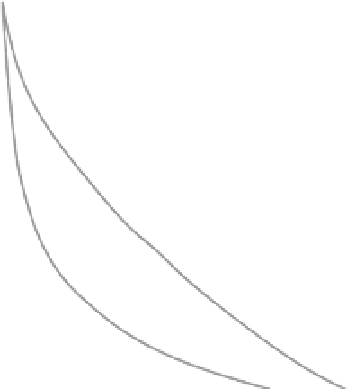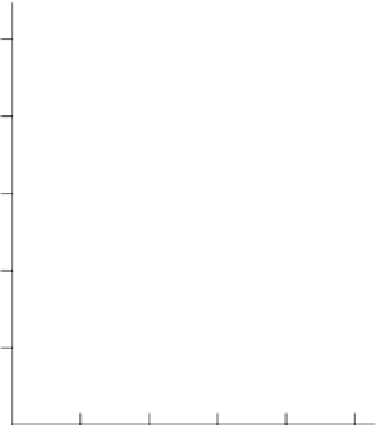Agriculture Reference
In-Depth Information
(Castilla and Lopez-Galvez, 1994). In pep-
per, a high plant density allows for the
achievement of LAI values of 5.0, versus an
index of 3.2 with low plant density (Lorenzo
and Castilla, 1995). In the same way, under
good temperature conditions, the LAI is
higher. For a greenhouse melon crop, the
value established for an early cycle (colder)
was 2.5, versus 4.6 for a late cycle (Castilla
et al
., 1996).
The radiation absorbed by a crop, and
which is used for photosynthesis, is much
more difficult to calculate than the inter-
cepted radiation (see Appendix 1 sections
A.5.1 and A.5.2).
100
80
60
Erect
leaves
40
20
Horizontal
leaves
0
Light penetration in the crop
0
2
4
6
8
10
LAI
A fraction of the radiation incident on top
of a canopy penetrates into the vegetation,
depending on the amount of leaves (that
is, the LAI) and their disposition in the
canopy.
The extinction coefficient (see
Appendix 1 section A.5.1) represents the
efficiency of the canopy to intercept radia-
tion in its different layers (Giménez, 1992).
A crop with horizontal leaves requires
less leaf area to intercept the same propor-
tion of radiation than another crop with
more erect leaves (which let more light pass
to the lowers layers) (Fig. 6.11).
Diffuse radiation, being non-directional,
has greater penetration in the vegetation as
it is more efficient than direct radiation
which causes more shadows in the crop's
lower layers.
Fig. 6.11.
Penetration of solar radiation in a canopy
as a function of the leaf area index (LAI) for two
types of crops: one with erect leaves and one with
horizontal leaves (according to Giménez, 1992).
CAM plants, C3 legume plants, C3 non-
legume plants (Varlet-Grancher
et al.
, 1982).
C4 plants are less efficient converters of
light into biomass than C3 plants, but their
C4 mechanism allows them to limit pho-
torespiration losses (in relation to C3 plants),
so they are more productive (Whatley and
Whatley, 1984).
In the absence of other limiting factors,
for an adult horticultural crop which covers
the ground well, and under normal condi-
tions, the average efficiency of conversion
(in grams of biomass per megajoule of glo-
bal radiation) is of the order of 1 g MJ
−1
(Baille, 1995). The maximum value of the
efficiency of conversion of radiation into
dry matter is of the order of 2.5 g MJ
−1
of
accumulated global radiation or 5.0 g MJ
−1
of accumulated PAR (Russell
et al.
, 1989).
The efficiency of the conversion will
depend on the radiation conditions. If all
radiation is diffuse, the efficiency will be
higher than if direct radiation prevails, with
values ranging between 0.8 and 1.4 g MJ
−1
(Challa
et al.
, 1995). For this reason, light-
diffusing plastics are so interesting in green-
house production, provided they do not
limit transmissivity. With CO
2
enrichment,
6.9.3
Efficiency in the use of
solar radiation
There is a linear relationship between the
accumulation of biomass (dry matter) dur-
ing a certain period and the accumulated
PAR during that period, which was inter-
cepted by the crop (section 6.9.1), provided
there are no other limiting factors present.
The efficiency in the conversion of the
intercepted radiation into dry matter, under
non-limiting crop growth conditions,
depends on the type of the plant: C4 plants,


